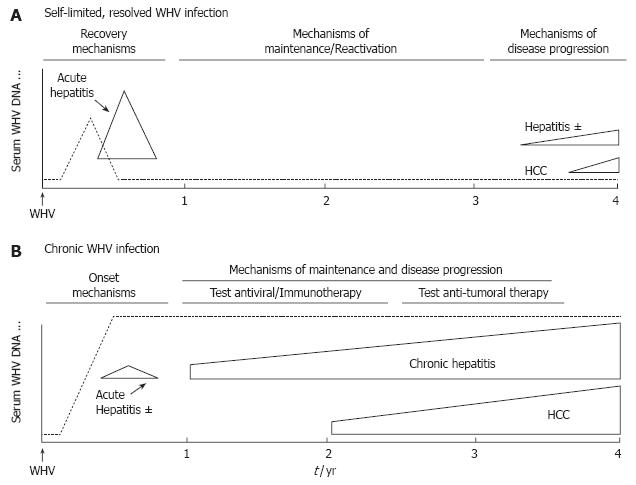Copyright
©2007 Baishideng Publishing Group Co.
World J Gastroenterol. Jan 7, 2007; 13(1): 104-124
Published online Jan 7, 2007. doi: 10.3748/wjg.v13.i1.104
Published online Jan 7, 2007. doi: 10.3748/wjg.v13.i1.104
Figure 3 Schematic profiles for viremia, acute hepatitis, and disease progression in the neonatal model of experimental WHV infection.
A: Self-limited, resolved WHV infection; B: Chronic WHV infection. Neonatal woodchucks born to WHV-negative dams are infected experimentally at 3 d of age with 5 x 106 woodchuck infectious doses 50% of a defined WHV inoculum by the subcutaneous route. Approximate time intervals for self-limited acute hepatitis and progressive chronic hepatitis are shown. Use of the neonatal WHV infection model enables co-temporal comparisons of acute self-limiting and chronic outcome of WHV infections as they develop. Comparison of acute phase events at early time points before or near the times when self-limited, resolved and chronic outcomes begin to segregate based on serologic criteria allows the definition of immune mechanisms involved in progression toward recovery versus chronicity. Comparison at later time points enables the investigation of mechanisms that are important in the maintenance of the established WHV infection state and that lead to disease progression and tumor development. During this time the established chronic WHV carrier woodchucks are used mainly for the testing of antiviral nucleosides, immunotherapeutic strategies, and for the prevention of onset and development of HCC.
- Citation: Menne S, Cote PJ. The woodchuck as an animal model for pathogenesis and therapy of chronic hepatitis B virus infection. World J Gastroenterol 2007; 13(1): 104-124
- URL: https://www.wjgnet.com/1007-9327/full/v13/i1/104.htm
- DOI: https://dx.doi.org/10.3748/wjg.v13.i1.104









